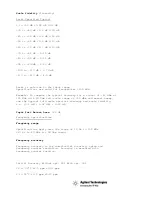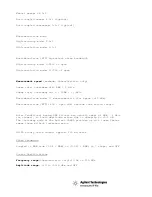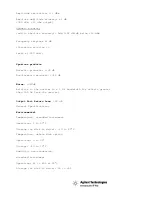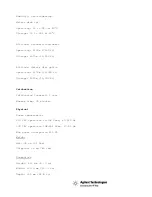
above 30 KHz to 100 MHz.
Specified for swept spectrum mode, with 50 Ohm input and low-distortion
mode off. Degrade 10 dB if in low-distortion mode and 2 dB if using
75 Ohm input.
For 1M Ohm input, noise is <-110 dBm/Hz below 40 MHz, with 1/f corner at
100 kHz.
Input noise is degraded 4 dB in narrowband zoom mode for spans >10 kHz, and 3 dB
for start frequency <30 kHz.
Note: Equivalent noise bandwidth is narrower than 1 Hz for spans below
150 Hz in the narrowband zoom mode, providing additional reduction in
phase noise from that shown above. This maintains good dynamic range,
even for extremely small offset frequencies in narrow spans. Noise is
reduced by 10 × log [1/noise bandwidth] dBc relative to the above graph.
Spurious Responses
General Spurious
Unless specifically mentioned in other spurious specifications, spurious
responses are <-70 dBc for signal levels = range. (<-80 dBc typical)
Harmonic distortion
Low-distortion mode, 50 and 75 Ohm inputs: Harmonic distortion products
are <-80 dBc (<-90 dBc typical) for spectrally pure input signals with
total input power level = range. Degrade specification by 10 dB when
low-distortion mode is off.
1M Ohm input:<-65 dBc (<-75 dBc typical)
Degrade harmonic distortion specifications by 10 dB (5 dB for 1M Ohm input) when
input frequency is less than 30 kHz.
Intermodulation distortion
Low-distortion mode, 50 and 75 Ohm inputs: Intermodulation distortion
products are <-80 dBc (<-90 dBc typical) with respect to 2 tones 6 dB
below range. Degrade specification by 10 dB when low-distortion mode
is off.
1M Ohm input: <-65 dBc (<-75 dBc typical)
Degrade intermodulation distortion specifications by 10 dB (5 dB for 1 MOhm
input) when input frequency is less than 30 kHz.








